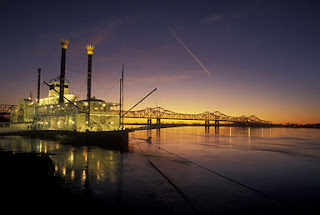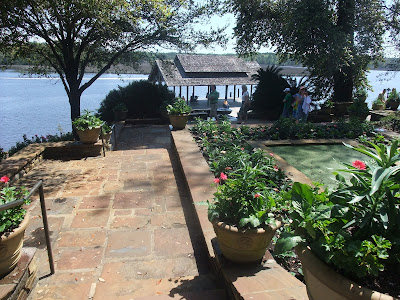
Arriving in southeastern Louisiana, straddling the Mississippi, to a place like none other on Earth, it didn’t take us long to discover the richness of New Orlean’s culture and heritage.She dawns nicknames such as "The Crescent City" for the bend in Ole Miss,"The Big Easy", "The City That Care Forgot" with Hurricane Katrina, “Cities of the Dead” for the numerous cemeteries, " Nawlins" and "NOLA" (acronym for New Orleans, Louisiana). The wonderful feeling of history in the city, the beautiful architecture (wrought iron balconies and beautiful Garden District homes) and the vibrant liveliness of the atmosphere is definitely something to experience.
The city is a living, breathing character in itself and it embraces its visitors. Oh, and then there is the FOOD!!! NOLA is classy, stylish, flamboyant, bohemian, outlandish, bright, garish, tarnished, rich, musical and intoxicating.
The French Quarter and Jackson Square is truly the heart of old New Orleans.


Inside St. Louis Cathedral the beautiful artwork painted on the ceiling is amazing and reminds one of the Vatican.
The Cabildo old government building to the left of the Cathedral really shed light particularly about New Orleans' unique culture steeped in Spanish, French, and Colonial influence. Two very important events in American history took place in this building; the 1803 Louisiana Purchase and the Plessy vs. Ferguson segregation case. If that wasn't reason enough for a history buff to come here, the Cabildo also had great exhibits on all aspects of New Orleans and covered the history of Louisiana in great detail. The death mask of Napoleon however was a notable exception. There are good temporary exhibitions on the history of rock and roll in New Orleans and the steamboats that plied their trade on the Mississippi.
 |
| New Orleans survives and thrives after the 2005 Hurricane Katrina |
 |
| Blaine Kern Art Studio does most of the Mardi Gras floats |
Crossing to the right of St. Louis Cathedral was another old government building known as the Presbytere. Built on the site of the residence of Capuchin monks in 1793, the site is part of the Louisiana State Museum complex and houses the Louisiana Portrait Gallery and historical exhibits. We were fortune to see two excellent exhibits on display regarding Hurricane Katrina in 2005 and the history of Mardi Gras. There the whole ground floor was given over to a very moving multi-media display on Katrina. The exhibition is shocking, touching and very informative. It covers all of the perspectives - from those right in the middle of everything to the government & media reactions. It was really interesting to read the personal accounts and see the personal artifacts like the axe from an attic, one survivor's jeans, a Jewish synagogue’s ruined Torah, an entire garage door with writing about one’s dead dog, etc. It has an excellent portrayal of hurricanes Katrina in NOLA and Rita in Texas, without placing blame on any one person or entity. The people who assembled this exhibition did a wonderful job.


The Mardi Gras exhibition on the second floor naturally felt more uplifting afterwards. When you see costumes, invitations, party throws and balls, dance cards, traditions, krewes - although not all krewes are represented-of the 54 parades usually held throughout the city, films, various court parade jewels, and memorabilia galore highlighting some of the events within the two weeks of Mardi Gras festival, it really all comes to life. As the guard announced at 5:00pm the building was closing, we were amazed how fast the time had flown by so quickly that afternoon. Dinner at the Gumbo Pot for drinks and some Cajun food wrapped up that rainy day. Creole Gumbo Combo for JR and Jambalaya for me.

Several bands and individual artists like to play jazz on the corners of Decatur, Royal, and Chartes streets. So listening to them as you stroll pass galleries and antique shops is rather upbeat. Not exactly a venue for revelry although a nice respite from the frat-boy atmosphere that dominates less impressive New Orleans iconic Bourbon Street. It has gotten pretty dirty and the loud blaring renditions of Brick House and Sweet Home Alabama really don't do justice to the Birthplace of Jazz.

We did stop at Cafe Beignet to listen to some good jazz tunes sung by Steamboat Willie accompanied with a bass player.Ordering the famous beignets to try became a must try while there. These huge, freshly made doughnuts covered with powder sugar were so yummy, that another morning while at the famous Café Du Monde we were enticed to try more beignets again.
 |
| Garden District Mansion |
 |
| Antebellum Home |
 |
| Beads hang as a reminder of Mardi Gras |
We walked through Lafayette Cemetery with its above ground tombs
NOLA is divided into parish districts so we hopped a streetcar and spent a morning walking the Garden District. Lovely old antebellum houses with grand architectural features seemed a far cry from the not so impressive Bourbon St. in the French Quarter. That same afternoon just north of the Convention Center along the Riverfront area we had the famous New Orleans muffuletta sandwich.

Then we walked forever to find a place called Mardi Gras World where many of the Mardi Gras floats are kept. Their artistic staff at Mardi Gras World makes most, if not all, of the props that go on the floats for the 54 parades held. WOW, what a little gem of an attraction! Chocked full of all of Mardi Gras's best - this was a real working factory and museum.
The short movie at the start, and a super good tour guide, brought all the celebration and splendor alive for us! We were treated to traditional Mardi Gras King Cake and then spend time in awe of the artistry of the floats and other cool exhibits! Amazing how they let us just wander around the warehouse and take photos of all the creations at our leisure.
A huge thunder and lightning storm hit the city on our last two days. However we continued to make the most of it being first timers to New Orleans. For the first time in two months our weather started to feel cold outside. At the open stalls of the French Market vendors pedal their wares rain or shine each day. It is a bustling place and a shopping haven galore.
Around the corner we shook out our umbrella at Preservation Hall to see the Jazz musician exhibit. It also gave a chance hear a 90-minute live jazz rendition inspired with a Buddhist twist. Now that was the real reason for coming to Nawlins as JR would say.
 |
| Louis Armstrongs first cornet displayed at Preservation Hall |
 |
| Many jazz musicians learned from the best of the old timers at Preservation Hall |
 A thunderstorm cleared enough making it a safe 160 mile drive from New Orleans through Baton Rogue to Natchez, Mississippi. The last part of the trip was pleasant and scenic passing along lush green countryside. It felt good to be back in sunshine for a change. A lovely campsite for four days at Riverside RV Resort overlooking the Mississippi River set us up.
A thunderstorm cleared enough making it a safe 160 mile drive from New Orleans through Baton Rogue to Natchez, Mississippi. The last part of the trip was pleasant and scenic passing along lush green countryside. It felt good to be back in sunshine for a change. A lovely campsite for four days at Riverside RV Resort overlooking the Mississippi River set us up. The first night we watched a spectacular sunset on the bluff of the river and attended an evening performance at the community auditorium entitled Historic Natchez Tableaux. It showcased the history of Natchez with Southern belles and gentlemen of all ages in period costumes.
The first night we watched a spectacular sunset on the bluff of the river and attended an evening performance at the community auditorium entitled Historic Natchez Tableaux. It showcased the history of Natchez with Southern belles and gentlemen of all ages in period costumes.

 A Powwow circle gathering at the Grand Village of the Natchez happened to occur on the weekend of our visit. It was a lucky chance to listen to Indian drummers and chants plus watch dancers in colorful costume regalia representing their southern native tribes. Unfortunately missing were the Natchez people as their nation had been completely wiped out by the French in 1730.
A Powwow circle gathering at the Grand Village of the Natchez happened to occur on the weekend of our visit. It was a lucky chance to listen to Indian drummers and chants plus watch dancers in colorful costume regalia representing their southern native tribes. Unfortunately missing were the Natchez people as their nation had been completely wiped out by the French in 1730.


























































